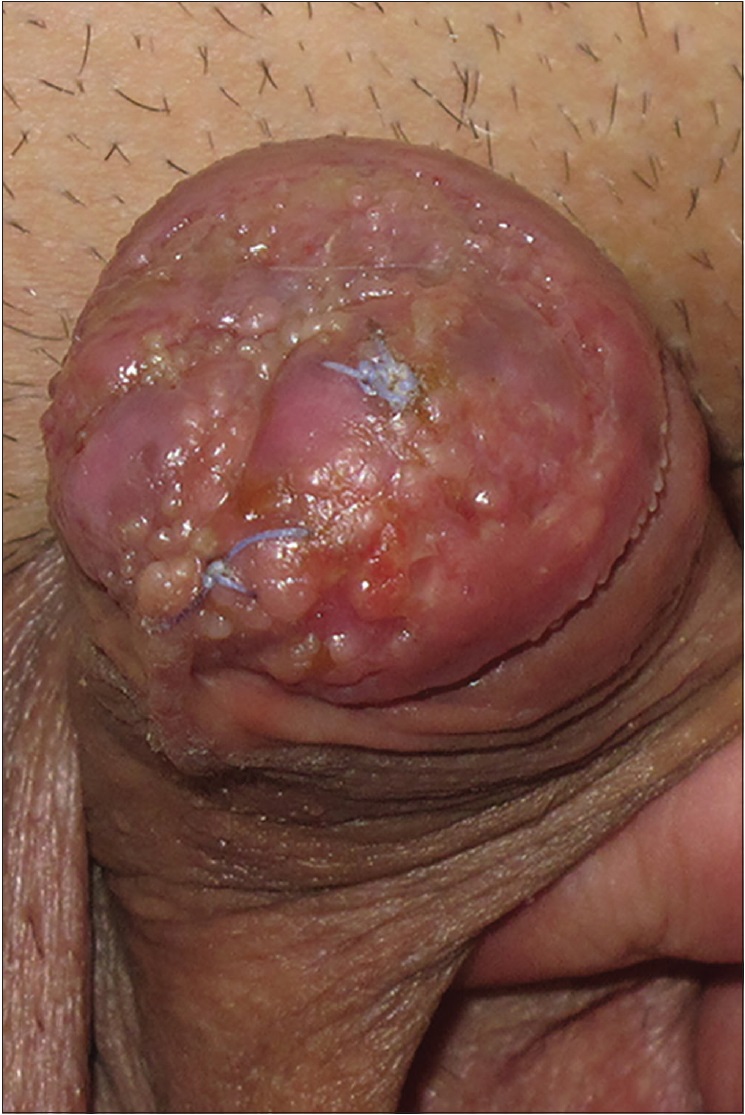Translate this page into:
Penile tuberculosis: A case report
2 Department of Pathology, Haydarpaşa Numune Training and Research Hospital, Istanbul, Turkey
Corresponding Author:
Sema Aytekin
Department of Dermatology, Haydarpaşa Numune Training and Research Hospital, Tıbbiye Street, Üsküdar, Istanbul 34668
Turkey
semaaytekin@yahoo.com
| How to cite this article: Aytekin S, Göktay F, Yasar &, Ferhatoǧlu ZA, Güneş P. Penile tuberculosis: A case report. Indian J Dermatol Venereol Leprol 2017;83:357-359 |
Sir,
Tuberculosis is an important public health problem with global incidence of about 9 million cases, mostly occurring in the developing countries, accounting for high mortality and morbidity.[1] Although the prevalence, incidence and mortality rates of tuberculosis have been declining lately in Turkey, sporadic cases continue to be detected. The incidence of tuberculosis in Turkey was found to be 20/100,000 in 2013.[2] The genitourinary tract is the most common site for extrapulmonary tuberculosis. Penile tuberculosis is a rarely reported variant comprising less than 1% of all genital tuberculosis cases in males.[1],[3],[4],[5],[6] Penile involvement secondary to urethral tuberculosis is even rarer.[4] Here we report a case of penile tuberculosis secondary to urethral involvement successfully treated with antitubercular therapy.
A 53-year-old man presented with multiple asymptomatic papules on his glans penis along with difficulty and pain during urination for the last 15 months. He had undergone surgery for urethral stricture 3 months back coupled with biopsy and histopathologic examination. Gradually the papular lesions ruptured and ulcerated alleviating his problems during micturition. Dermatological examination revealed multiple cribriform and punched-out ulcers, papules and scars involving the entire glans penis [Figure 1a] and [Figure 1b]. There was no significant inguinal lymphadenopathy. He had a scar from the Bacillus Calmette–Gué rin vaccine. Hair, nails and mucosae were spared. His wife was not found to be suffering from genital tuberculosis. His father had suffered from pulmonary tuberculosis in the past. Tuberculin test was positive showing an induration of 15 mm. Interferon-gamma release test was positive at 10 IU. Other investigations, such as chest radiograph and abdominal and pelvic sonography failed to detect any foci of tuberculosis elsewhere in the body. Human immunodeficiency virus and Venereal Disease Research Laboratory tests were also negative. Biopsy from the edge of the ulcer showed epithelioid cell granuloma along with necrosis, lymphocytic cuff and multinucleated giant cells. [Figure 2a] and [Figure 2b]. These findings were similar to that of histopathologic examination of the biopsy specimen obtained during the stricture operation. Fite stain and polymerase chain reaction (PCR) on the tissue sample for Mycobacterium tuberculosis were negative. These features were consistent with diagnosis of penile tuberculosis. Four-drug combination therapy of rifampicin, isoniazid, pyrazinamide and ethambutol was given for initial 2 months followed by a combination of rifampicin and isoniazid to complete a total of 9 months of standard antituberculous therapy. Complete healing with residual depressed scars was achieved after 6 months of therapy [Figure 1c] and [Figure 1d].
 |
| Figure 1a: Multiple cribriform and punched-out ulcers, tiny yellowish papules and scars on the entire glans penis |
 |
| Figure 1b: Lesions on the dorsal aspect of the glans penis |
 |
| Figure 2a: Granulomas with focal caseating necrosis, surrounded by lymphocytic cuff (H and E, ×200) |
 |
| Figure 2b: Multinucleate giant cells and tuberculoid granulomas with a variable mantle of lymphocytes in the mid-dermis (H and E, ×400) |
 |
| Figure 1c: Complete healing with atrophy after 6 months of antituberculous therapy |
 |
| Figure 1d: Post treatment image of the lesions on the dorsal aspect of the glans penis |
Penile tuberculosis may occur as primary or secondary tuberculosis or tuberculid.[1],[3],[4],[5],[6] Skin, glans, or cavernous bodies of penis may be involved. In most cases ulcerated lesions occur, as in our case; however, nodular or papulonecrotic lesions also occur frequently. Positive tuberculin test, evidence of past tuberculosis, characteristic histopathology, and favourable response to anti-tubercular treatment are the pointers to the diagnosis. Isolated penile involvement may make the diagnosis challenging, as in our case, in case a proper history is not taken. Tuberculosis of the penis may occur by direct contact with a sexual partner who has urogenital tuberculosis. Gupta et al. reported four cases of penile tuberculosis, in one of which the wife had endometrial tuberculosis. Therefore, the female partner should always be evaluated for genital tuberculosis.[5] In our case, the female partner had no evidence of urogenital tuberculosis.
Atypical clinical presentations mimicking other inflammatory and neoplastic conditions may result in a delay of diagnosis and treatment of the disease. Penile amputation with a strong suspicion of cancer has been reported in a case with a final diagnosis of penile tuberculosis.[6]
We have reported this case to emphasize the importance of considering tuberculosis as an underlying cause of non-healing penile ulcers. In such cases, a high index of suspicion is necessary to make an early and correct diagnosis to initiate proper treatment.
Financial support and sponsorship
Nil.
Conflicts of interest
There are no conflicts of interest.
| 1. | Venyo AK. Tuberculosis of the penis: A review of the literature. Scientifica (Cairo) 2015;2015:601624. [Google Scholar] |
| 2. | Available from: www.saglik.gov.tr/TR/dosya/1-101702/h/yilliktr.pdf. [Last accessed on 2016 Nov 02]. [Google Scholar] |
| 3. | Deb S, Mukherjee S, Seth J, Samanta AB. Nodulo-ulcerative tuberculosis of the glans penis-A case report and a discussion on nomenclature of genital tuberculosis. Indian J Dermatol 2015;60:506-8. [Google Scholar] |
| 4. | Vijaikumar M, Thappa DM, Kaviarasan PK. Papulonecrotic tuberculide of the glans penis. Sex Transm Infect 2001;77:147. [Google Scholar] |
| 5. | Gupta V, Bhatia R, Singh UB, Ramam M, Gupta S. Penile 'tuberculid': Could it be sexually acquired primary inoculation tuberculosis? J Eur Acad Dermatol Venereol. 2016;30:164-6. [Google Scholar] |
| 6. | Savu C, Surcel C, Mirvald C, Gîngu C, Hortopan M, Sinescu I. Atypical primary tuberculosis mimicking an advanced penile cancer. Can we rely on preoperative assessment? Rom J Morphol Embryol 2012;53:1103-6. [Google Scholar] |
Fulltext Views
4,379
PDF downloads
2,110





